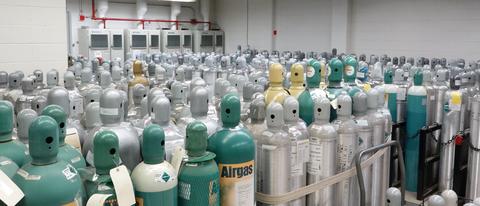Summary
Two NIST programs provide calibration gas standards with NIST analyses and concentration value assignment: the Standard Reference Material (SRM) program and the NIST Traceable Reference Material (NTRM) program. The gas standards are mixtures contained in high-pressure compressed gas metal cylinders. In the SRM program, NIST initiates the production of mixtures, then analyses every SRM mixture and issues a Certificate of Analysis. Specialty gas companies initiate NTRM mixture production with NIST concurrence and analyze 100% of the cylinders; NIST analyzes 10% of the cylinder lot and issues a Certificate of Traceability. For the EPA Protocol Gas Program, specialty gas companies follow an EPA document to blend and analyze individual mixtures using SRMs or NTRMs for their certification.
Description

The Gas Mixture SRM, NTRM, and EPA Protocol Programs provide a mechanism to produce needed calibration gas standards with a well-defined traceability. These mixtures are specified in the Code of Federal Regulations (CFR) to calibrate instruments to be used to monitor regulated emissions. The NTRM program was developed to augment the SRM program because the SRM program could not provide all of the needed standards. An SRM is a gas standard provided to NIST by a sub-contractor who has prepared it according to NIST technical specifications. The SRM is certified by NIST against primary gas standards which are prepared by NIST and which have undergone rigorous validation both at NIST and internationally. The SRM is then sold to users through the NIST's SRM Program.
The NTRM program is a collaboration between NIST and a specialty gas company to certify a production lot of gas standards. A specialty gas company produces a lot of NTRM candidate gas standards according to NIST technical specifications. The vendor then analyzes all of the cylinders comprising that lot against a NIST gas standard and sends the data to NIST. NIST analyzes the data and if the data passes our initial screening, selects 10% of the cylinders for NIST audit. NIST certifies the lot based upon the vendor data and the NIST data. The vendor is then responsible for the NTRM cylinders, and can use them internally to produce protocol gases, or they may sell them to customers. Recently the NTRM program was expanded to include the NTRM Prime (NTRM*), where NIST analyzes every sample to address the needs of certain customers.
These two programs cannot provide all of the needed standards required by EPA so the Protocol Gas program was initiated. An EPA Protocol Gas standard is a standard prepared according to a procedure published by EPA. It defines a method to gain NIST traceability for gas standards, and it requires an SRM or NTRM for that traceability. To provide quality assurance for the Protocol Gases, NIST worked with EPA to set up a program for blind sampling of mixtures that are analyzed at NIST and the results are compared to information provided in the producer's certificate. Certification measurements for all three programs are accomplished according to government and industry quality programs.
Associated Publications
1. Srivastava, A., Long, S. E., Norris, J. E., Bryan, C. E., Carney, J., and Hodges, J. T., "Comparison of Primary Laser Spectroscopy and Mass Spectrometry Methods for Measuring Mass Concentration of Gaseous Elemental Mercury," Analytical Chemistry, 93, 1050-1058 (2021).
2. Long, S. E., Norris, J. E., Carney, J., and Ryan, J. V., "Provision of primary NIST traceability to support vapor phase mercury emissions monitoring of combustion sources using isotope dilution inductively coupled plasma mass spectrometry," Atmospheric Pollution Research, 11, 909-919 (2020).
3. Norris, J. E., Choquette, S. J., Viallon, J., Moussay, P., Wielgosz, R., and Guenther, F. R., "Temperature measurement and optical path-length bias improvement modifications to National Institute of Standards and Technology ozone reference standards," Journal of the Air & Waste Management Association, 63, 565-574 (2013).
4. Leiva, M. A., Araya, C., Mancilla, C., Seguel, R., and Norris, J. E., "Uncertainty of ozone measurements with the primary standard reference photometer (SRP45)," Talanta, 86, 71-81 (2011).
5. Viallon, J., Moussay, P., Norris, J. E., Guenther, F. R., and Wielgosz, R. I., "A study of systematic biases and measurement uncertainties in ozone mole fraction measurements with the NIST Standard Reference Photometer," Metrologia, 43, 441-450 (2006).
Major Accomplishments
- In the past two years, we have certified 490 gas mixture SRM cylinders
- Certified over 2,100 gas mixtures NTRM cylinders
- Provided support of EPA Protocol Gas Program supporting Acid Rain Regulations
- Provided support to the automobile industry for compliance with regulations

